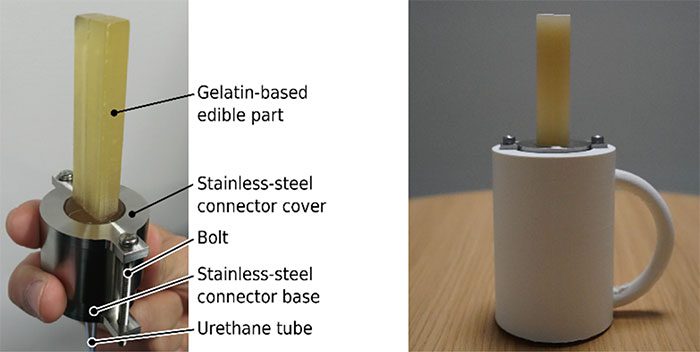A research team at the Japan Electronic and Telecommunications University has successfully developed the world’s first “edible robot”, opening up potential for new and surprising culinary experiences.
A rectangular, translucent yellow gummy candy, about 7 cm long, sways back and forth, waving its gelatin arms in a friendly greeting. The entire candy is housed within a cup. Remarkably, the candy can also speak: “Hello. I would like to talk to you today.”

The edible part of the robot is just a soft gummy candy.
Thanks to the development by the research team, led by Associate Professor of Robotics Yoshihiro Nakata from Japan’s Electronic and Telecommunications University, this is no longer an ordinary apple-flavored gummy candy but the world’s first edible robot.
The edible part of the robot is just a soft gummy candy, but the base of the candy is integrated with robotic technology that creates realistic movements. With tiny, jet-black eyes, the edible body of the robot is attached to a stainless steel bolt placed inside a 3D printed cup. The internal chambers of the gummy contain air and connect to a pneumatic tube at the base of the device to create movement. Sounds emitted from a speaker connected to the device further enhance the robot’s liveliness.
Associate Professor Nakata shared: “Our goal is to provide an edible robot as a new culinary experience.” He explained that this idea was inspired by Anpanman, a famous Japanese superhero cartoon character shaped like a red bean paste bun. Additionally, the gummy robot is inspired by the traditional Japanese culinary practice of “odorigui,” which involves eating seafood that is still alive and moving.
The research team conducted experiments to analyze participants’ perceptions while enjoying the “edible robot.” The results showed that when the robot moved, participants perceived its texture as chewier and slightly firmer compared to when the robot was stationary. Furthermore, they reported sensations of freshness, liveliness, and even feelings of guilt when consuming the robot.
Associate Professor Nakata believes these differences may stem from how people interact with food, thereby creating changes in taste and texture, leading to various psychological and perceptual effects.
Currently, there is not much research on the relationship between robots and palatability. However, Associate Professor Nakata is confident that edible robots could have many applications in the future, such as helping people eat foods they dislike or being used in medicine to assist patients with eating disorders.




















































